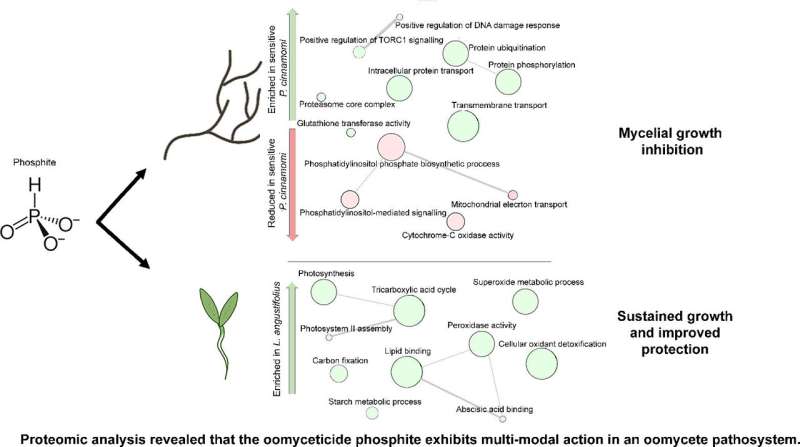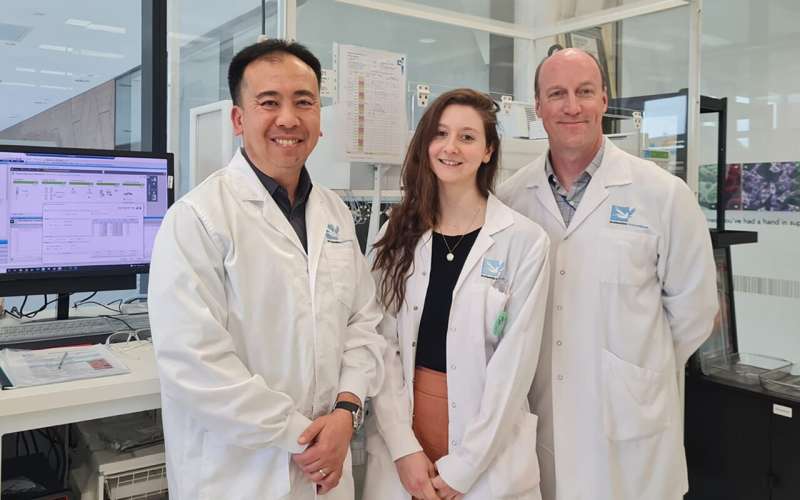This article has been reviewed according to Science X's editorial process and policies. Editors have highlighted the following attributes while ensuring the content's credibility:
fact-checked
trusted source
proofread
Proteomic analysis reveals how phosphite contributes to the fight against chemically resistant dieback

Having previously confirmed dieback is resistant to chemical control on crops such as avocados, stone fruits and pines, Curtin University researchers have gained new insights into how phosphite works against the fungus-like disease, in a potential breakthrough for growers.
The paper is titled "Proteomic analysis revealed that the oomyceticide phosphite exhibits multi-modal action in an oomycete pathosystem," and it has been published in the Journal of Proteomics.
Researchers from Curtin's Center for Crop and Disease Management (CCDM) and Proteomics International will use the new findings to develop a detection tool to help limit the spread of dieback caused by the pathogen Phytophthora cinnamomi, which can lead to huge economic losses in the horticultural industry as well as devastate native flora.
Lead author and recent CCDM Ph.D. graduate Dr. Christina Andronis, along with her CCDM supervisor Associate Professor Kar-Chun Tan and CCDM fungicide resistance expert Associate Professor Fran Lopez-Ruiz, found phosphite works in three ways to control dieback.

"First, phosphite targets the pathogen directly and inhibits its growth. Secondly, it can act through the plant and increase its natural defense against dieback, and thirdly, it can cause a 'greening effect' on the plant by amping up the production of proteins that are associated with photosynthesis," Dr. Andronis said.
"Before now, how this compound worked was a bit of a mystery, with many believing phosphite only improved the plant's defense system against the disease and its interaction with pathogen was not understood.
"We've been able to show this chemical is extremely valuable for horticulture production due to its three modes of action. One of these modes involves enhancing photosynthesis, potentially leading to improved yields but further studies are needed to confirm this.
"As phosphite is the only chemical used to control dieback commercially, we need to ensure it remains useful for producers for the long term."
Associate Professor Tan said the next step of the research is to work out the genetic basis for resistance and pinpoint the gene within the dieback pathogen that has enabled it to survive chemical applications.
"If we discover the gene responsible, which we are confident we can do here at CCDM, we can then develop molecular detection tools for the rapid and accurate detection of resistant dieback, and we can help producers make the relevant management changes needed in a timely manner," Associate Professor Tan said.
"We've seen in the grains and grape industries, when fungicide resistance gets out of hand, it can be devastating, costing industries hundreds of millions of dollars in reduced yield, with limited control options.
"But we're optimistic this won't happen in the horticultural industry, because at CCDM we have many years of fungicide resistance research we can draw upon to help prevent such an epidemic."
CCDM Director Professor Mark Gibberd said CCDM has a strong history in studying the mechanisms behind fungicide resistance, as the leading research organization in Australia in this field.
"In recent years we've learnt a lot about the way fungicide resistance works in multiple pathogens affecting many grains and horticultural crops across Australia," Professor Gibberd said.
"While this case of dieback resistance is very concerning to the horticultural industry, it's not an uncommon story in other crops in other industries, and at CCDM we have the advantage of being able to delve into an extensive understanding on chemical resistance and how it works and use this to find solutions."
More information: Christina E. Andronis et al, Proteomic analysis revealed that the oomyceticide phosphite exhibits multi-modal action in an oomycete pathosystem, Journal of Proteomics (2024). DOI: 10.1016/j.jprot.2024.105181
Provided by Curtin University





















